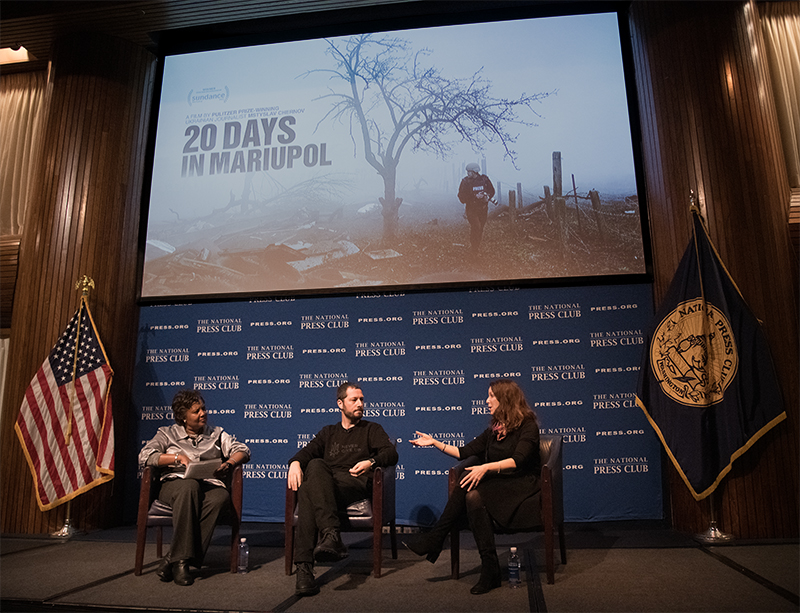AP Journalist Mstyslav Chernov screens award-winning documentary '20 Days in Mariupol' at Press Club
"I wish I could do more, and stay longer," said Pulitzer-prize winning AP videographer and director Mstysalv Chernov in his documentary, "20 Days in Mariupol."

The documentary, produced by the Associated Press and PBS' Frontline, and shown at a screening at the National Press Club on Nov. 3. shows an existential crisis that journalists covering conflict face: how much do they continue to record? At what point do they intervene?
For Chernov, he confronted his own role in the war in Ukraine on day one. On camera, he is seen trying to calm civilians he passes, and often drops his camera at the request of others to stop filming. "I understand their anger. But it's my country, too," he said in the documentary. "And we have to tell its story."
And tell its story Chernov does. It wasn't until after his harrowing extraction in coordination by the Ukrainian military with the Red Cross that he learned that he was the last journalist in Mariupol, and the only one who recorded the first 20 days of Russia's invasion of the city. His camera and footage was smuggled through 15 Russian checkpoints before he was rescued. Other journalists were not so lucky.
Shot in 4K, Chernov struggled with balancing limited batteries and the ability to charge them, as well as card space and knowing how much footage to capture. He was driven to record as much as possible, realizing both the historic importance and the need to help discern the events as they unfolded.
"Every single detail matters," Chernov said. "You never know...[what will help] report war crimes in delicate situations." His main regret is not having more equipment, and not staying to record the deadliest bombings in the following days.
The brutal footage contains critical moments and emotional and strategic responses by Ukrainian civilians and military. Each agonizing day, Chernov struggled to find even a faint internet connection to send videos to AP editors. Sometimes, all he had was a satellite phone for communication -- and some days, not even that worked. Russia, noted by distinct "Z"s on their tanks and convoys, cut off electricity, communications and other essential resources early and quickly.
The documentary shares an illuminating look at the footage the world saw in the emerging days of the war: planes flying overhead; apartment buildings, schools, and a maternity hospital bombed; children who had their legs blown off while playing soccer; babies who died just hours after birth; crying doctors; and parents kissing their children for the last time.
Some footage will be familiar to audiences who watched the war unfold in 2022. But Chernov narrates and provides more context, and contrasts news broadcasts to his raw storytelling. He is determined to dispel the propaganda by Russia and naysayers who called his footage staged.
Chernov said his heart is "ripped apart by all of the filming and tragedies...but we just move on. My film didn't change the outcome... it's complex, and I have no illusions to what happens after we film, and how it gets [seen and shared]. Things can get misinterpreted. Journalism can't arguably stop the war. But I am disappointed."
Former NPC President Lisa Matthews, Associated Press U.S. planning manager, moderated a discussion with Chernov and Raney Aronson-Rath, editor-in-chief and executive producer of PBS’ Frontline, after the screening.
The film "focuses not on fighting, but on ordinary people simply trying to stay alive," Matthews said in her opening remarks. "It's a tough film to watch. But watching this film is an act of bearing witness."
Aronson-Rath reflected on the editing process, and shared that it was "torture" for Chernov, who wasn't able to finish telling stories of civilians he met. "But his life was on the line," she said, absolving Chernov of the guilt he still grapples with. In his first year at AP, he wanted his journalism to change the course of wars, and end pain and suffering.
Aronson-Rath and Matthews reminded Chernov and the audience that it wasn't until his footage of inside the siege of Mariupol was seen, did international communities, governments and nonprofit organizations negotiate for the creation of the Green Corridor, which allowed civilians to leave the city safely. Tens of thousands of lives were saved. "It was not for nothing. Journalism matters. You saved more lives just by telling your story," Aronson-Rath said.
